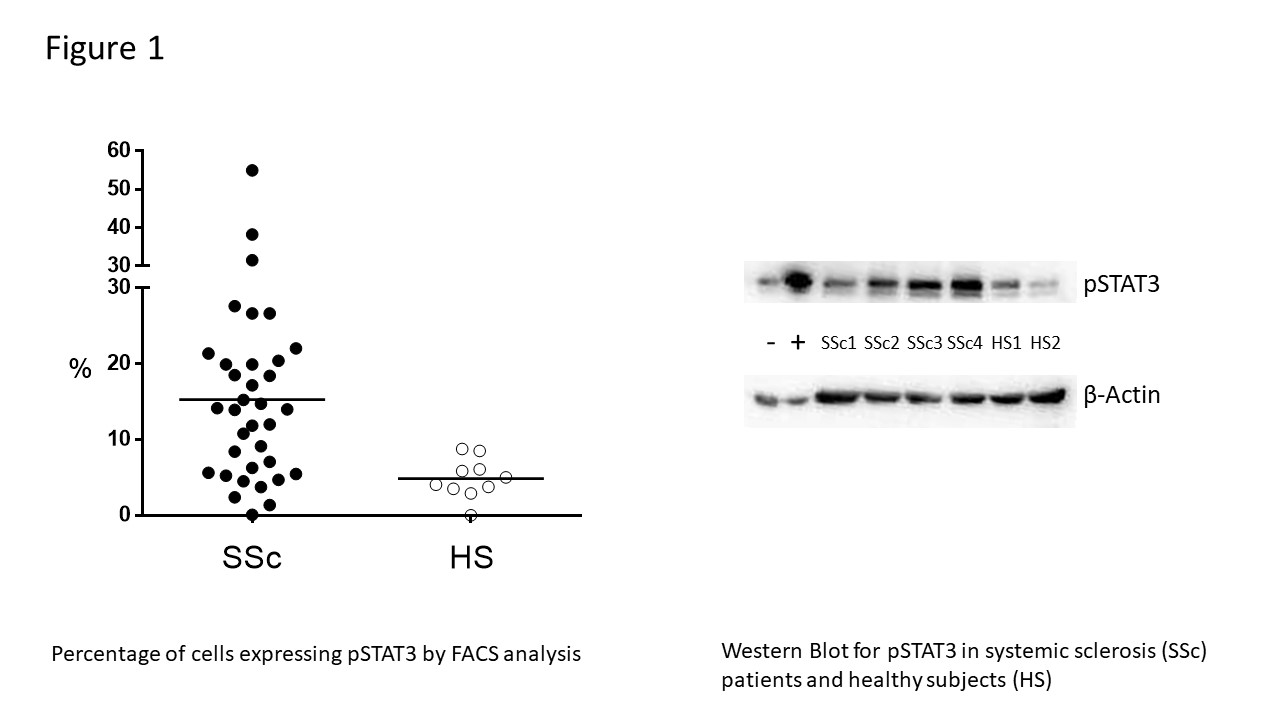Session Information
Date: Monday, October 22, 2018
Title: Systemic Sclerosis and Related Disorders – Basic Science Poster II
Session Type: ACR Poster Session B
Session Time: 9:00AM-11:00AM
Background/Purpose: Signal transducer and activator of transcription 3 (STAT3) is a transcription factor regulated by phosphorylation of key tyrosine residues that regulates pivotal cell processes such as growth and proliferation, apoptosis, and immune responses [1]. STAT3 pathway has been evaluated in different inflammatory rheumatic diseases, and findings from ex vivo and animal experimental model proposed the STAT3 pathway as a novel core mediator of fibrosis in systemic sclerosis (SSc) [2]. We evaluated the phosphorylated (p) STAT3 in peripheral blood mononuclear cells (PBMCs) from SSc patients.
Methods: Intracellular expression of phosphorylated and thus activated STAT3 was analysed in 35 SSc patients (female 30; 82% – median disease duration 96 months; 95%-CI 87-172), diagnosed according to the 2013 ACR/EULAR classification criteria, and 10 healthy matched subjects (HS) by FACS analysis and Western Blot. The level of STAT3 gene was studied by qPCR. pSTAT3 was correlated to demographic, clinical, laboratory and instrumental findings of SSc patients.
Results: pSTAT3 was found significantly higher in SSc patients compared to HS (3-folds higher; P=0.007) [Figure 1], and specifically with higher expression in CD14+ cells, while no difference in the expression of STAT3 levels was found. Patients with disease duration longer than 2 years showed higher pSTAT3 (P=0.01) and a direct correlation was found between months from diagnosis and pSTAT3 (r 0.38; P=0.01). We observed an inverse correlation between pSTAT3 and the modified Rodnan Skin Score (mRSS) (r -0.37; P=0.02). Significantly lower pSTAT3 activity was detected in patients with interstitial lung disease (ILD) compared to patients without ILD (P=0.006). Furthermore, we observed an inverse significant correlation between pSTAT3 and body mass index (BMI) (r -0.34; P=0.02). No correlations with markers of inflammation and specific autoantibodies were detected. Moreover, no differences in diffuse vs limited cutaneous subsets of the disease, pulmonary hypertension, or gastrointestinal involvement, steroid or immunosuppressive cumulative dose or ongoing treatment were found.
Conclusion: We have preliminary demonstrated higher pSTAT3 in SSc PBMCs with a specific expression in CD14+ cells without any modification of STAT3 expression. Patients with longer disease duration, lower mRSS and BMI, and no ILD presented an increased pSTAT3 activation. The changes in metabolic pathways related to disease duration may explain our findings [3]. Further studies could explain our intriguing results.
References.
1. Yu H, et al. Nat Rev Cancer. 2014;14(11):736-46.
2. Chakraborty D, et al. Arthritis Rheumatol. 2017; 69 (suppl 10).
3. Maniscalco JW, Rinaman L. Am J Physiol Regul Integr Comp Physiol. 2014;306(8):R576-85.
To cite this abstract in AMA style:
Cacciapaglia F, Perniola S, Urso L, Praino E, Bizzoca R, Natuzzi D, Lacarpia N, Iannone F. Signal Transducer and Activator of Transcription 3 (STAT3) Activation in Peripheral Blood Mononuclear Cells of Systemic Sclerosis Patients: Correlation with Disease Specific Manifestations [abstract]. Arthritis Rheumatol. 2018; 70 (suppl 9). https://acrabstracts.org/abstract/signal-transducer-and-activator-of-transcription-3-stat3-activation-in-peripheral-blood-mononuclear-cells-of-systemic-sclerosis-patients-correlation-with-disease-specific-manifestations/. Accessed .« Back to 2018 ACR/ARHP Annual Meeting
ACR Meeting Abstracts - https://acrabstracts.org/abstract/signal-transducer-and-activator-of-transcription-3-stat3-activation-in-peripheral-blood-mononuclear-cells-of-systemic-sclerosis-patients-correlation-with-disease-specific-manifestations/

